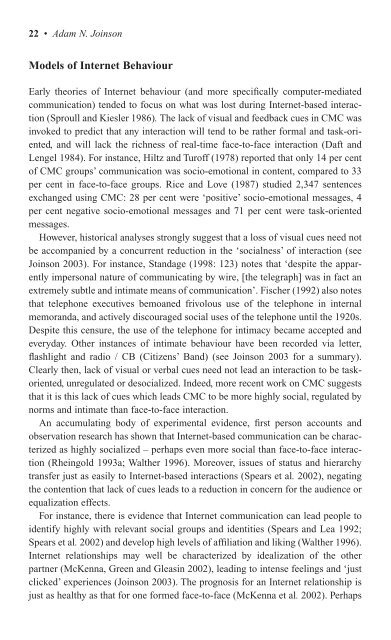Virtual Methods
Virtual Methods
Virtual Methods
You also want an ePaper? Increase the reach of your titles
YUMPU automatically turns print PDFs into web optimized ePapers that Google loves.
22 • Adam N. Joinson<br />
Models of Internet Behaviour<br />
Early theories of Internet behaviour (and more specifically computer-mediated<br />
communication) tended to focus on what was lost during Internet-based interaction<br />
(Sproull and Kiesler 1986). The lack of visual and feedback cues in CMC was<br />
invoked to predict that any interaction will tend to be rather formal and task-oriented,<br />
and will lack the richness of real-time face-to-face interaction (Daft and<br />
Lengel 1984). For instance, Hiltz and Turoff (1978) reported that only 14 per cent<br />
of CMC groups’ communication was socio-emotional in content, compared to 33<br />
per cent in face-to-face groups. Rice and Love (1987) studied 2,347 sentences<br />
exchanged using CMC: 28 per cent were ‘positive’ socio-emotional messages, 4<br />
per cent negative socio-emotional messages and 71 per cent were task-oriented<br />
messages.<br />
However, historical analyses strongly suggest that a loss of visual cues need not<br />
be accompanied by a concurrent reduction in the ‘socialness’ of interaction (see<br />
Joinson 2003). For instance, Standage (1998: 123) notes that ‘despite the apparently<br />
impersonal nature of communicating by wire, [the telegraph] was in fact an<br />
extremely subtle and intimate means of communication’. Fischer (1992) also notes<br />
that telephone executives bemoaned frivolous use of the telephone in internal<br />
memoranda, and actively discouraged social uses of the telephone until the 1920s.<br />
Despite this censure, the use of the telephone for intimacy became accepted and<br />
everyday. Other instances of intimate behaviour have been recorded via letter,<br />
flashlight and radio / CB (Citizens’ Band) (see Joinson 2003 for a summary).<br />
Clearly then, lack of visual or verbal cues need not lead an interaction to be taskoriented,<br />
unregulated or desocialized. Indeed, more recent work on CMC suggests<br />
that it is this lack of cues which leads CMC to be more highly social, regulated by<br />
norms and intimate than face-to-face interaction.<br />
An accumulating body of experimental evidence, first person accounts and<br />
observation research has shown that Internet-based communication can be characterized<br />
as highly socialized – perhaps even more social than face-to-face interaction<br />
(Rheingold 1993a; Walther 1996). Moreover, issues of status and hierarchy<br />
transfer just as easily to Internet-based interactions (Spears et al. 2002), negating<br />
the contention that lack of cues leads to a reduction in concern for the audience or<br />
equalization effects.<br />
For instance, there is evidence that Internet communication can lead people to<br />
identify highly with relevant social groups and identities (Spears and Lea 1992;<br />
Spears et al. 2002) and develop high levels of affiliation and liking (Walther 1996).<br />
Internet relationships may well be characterized by idealization of the other<br />
partner (McKenna, Green and Gleasin 2002), leading to intense feelings and ‘just<br />
clicked’ experiences (Joinson 2003). The prognosis for an Internet relationship is<br />
just as healthy as that for one formed face-to-face (McKenna et al. 2002). Perhaps



